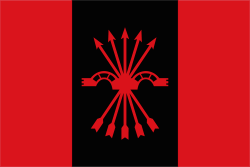National Radical Camp Falanga
National Radical Camp Falanga | |
|---|---|
 | |
| Founded | 14 April 1934 |
| Dissolved | 1939 |
| Headquarters | Warsaw, Poland |
| Ideology |
Polish nationalism National radicalism Falangism Antisemitism |
| Political position | Far-right |
| Part of a series on |
| Falangism |
|---|
 |
|
Literature
|
|
Related topics |
| Politics portal |
The Falanga National Radical Camp (Polish: Oboz Narodowo Radykalny-Falanga, ONR-Falanga), was a minor Polish political grouping of the 1930s, one of two to emerge following the split of the National Radical Camp (Polish: Oboz Narodowo Radykalny, ONR) in 1934.
Formation and ideology
The ONR-Falanga was formed in the spring of 1935 following a split by members of the National Radical Camp held in Detention Camp Bereza Kartuska. Adopting the name of Oboz Narodowo-Radykalny (National Radical Camp), it soon became known as Falanga after the title of its journal (the rival group would also soon be named after its own journal, thus becoming known as National Radical Camp-ABC).[1]
The Falanga was led by Bolesław Piasecki and advocated a 'Catholic totalitarianism' inspired by Spanish Falangism. However, although clearly derived from Falangism, it has been argued that their Catholicism was even more central than that of the Spanish group[2] and indeed their pronouncment that 'God is the highest form of man' recalled the religious fanaticism of Corneliu Zelea Codreanu.[3] The group is widely considered to have been a fascist movement.[1][4][5] Harshly critical of capitalism and supportive of removing citizenship rights from Poland's Jews[1] it presented itself as the vanguard of the opposition to Józef Piłsudski.[1]
Development
Largely based in university campuses, the Falanga followed a policy of anti-Semitism and although it had few members,[6] from its power bases in schools it attempted to launch attacks on Jewish students and businesses.[7] Left-wing activists were also as part of this violent activity.[1]
The group soon came under scrutiny from the Polish government. Indeed, unlike similar movements in other European countries who regularly held public rallies, the ONR-Falanga held only two such gatherings, in 1934 and 1937, both of which were quickly broken up by the police.[5]
For a time the movement became associated with the Camp of National Unity (Polish: Obóz Zjednoczenia Narodowego, OZN) as Colonel Adam Koc, impressed by the organisation of the ONR-Falanga, placed Piasecki in charge of the OZN youth group. Koc called for the creation of a one-party state and hoped to use the youth movement to ensure this although his pronouncements upset many pro-government moderates. As such, Koc was removed from the leadership of the OZN in 1938 and replaced by General Stanisław Skwarczyński who quickly severed any ties to the ONR-Falanga.[8]
Disappearance
As a Polish nationalist movement the ONR-Falanga opposed the German occupation of Poland after the 1939 invasion, and thus was quickly subsumed by the Konfederacja Narodu, a group within the Polish resistance that retained certain far right views.[1]
However, following the establishment of a communist puppet regime in 1945, Piasecki was allowed to lead the PAX Association (Polish: Stowarzyszenie PAX), a supposedly Catholic organisation that was in fact a front group of the NKVD which aimed to promote the new communist regime to Poland's Catholics whilst turning them away from the Vatican.[9]
See also
- Falange
- Camp of Great Poland
- National Radical Camp (1934)
- Confederation of the Nation
- PAX Association
- National Radical Camp (1993)
- National Revival of Poland
References
- 1 2 3 4 5 6 C.P. Blamires, World Fascism: A Historical Encyclopedia, ABC-Clio, 2006, p. 523
- ↑ Stanley G. Payne, A History of Fascism 1914-1945, London: Routledge, 2001, p. 262
- ↑ Payne, A History of Fascism, pp. 321-2
- ↑ P. Davies & D. Lynch, The Routledge Companion to Fascism and the Far Right, London: Routledge, 2002. p. 324
- 1 2 Norman Davies, God's Playground: A History of Poland Volume 2: 1795 to the Present, Columbia University Press, 1982, p. 262
- ↑ (Polish) Obóz Narodowo-Radykalny WIEM Encyklopedia
- ↑ J.W. Borejsza, "East European Perceptions of Italian Fascism, S. U. Larsen, B. Hagtvet & J. P. Myklebust, Who Were the Fascists: Social Roots of European Fascism, Scandinavian University Press, Oslo, 1980, p. 358
- ↑ Payne, A History of Fascism, p. 322
- ↑ Davies, God's Playground, p. 579